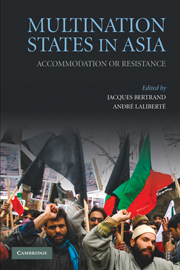Book contents
- Frontmatter
- Contents
- List of Tables and Figures
- List of Maps
- List of Contributors
- Acknowledgments
- Maps
- 1 Introduction
- 2 Revolutionary State Formation and the Unitary Republic of Indonesia
- 3 The Crisis of Border States in India
- 4 Pakistan: Neither State Nor Nation
- 5 Constitutional Politics and Crisis in Sri Lanka
- 6 The Dilemmas of Burma's Multinational Society
- 7 The Double-Edged Sword of Autonomy in Indonesia and the Philippines
- 8 China and the Virtual Taiwan Nation
- 9 The Failure of Ideologies in China's Relations with Tibetans
- 10 Leninism's Long Shadow in Central Asia
- 11 Conclusion
- References
- Index
8 - China and the Virtual Taiwan Nation
Published online by Cambridge University Press: 05 June 2012
- Frontmatter
- Contents
- List of Tables and Figures
- List of Maps
- List of Contributors
- Acknowledgments
- Maps
- 1 Introduction
- 2 Revolutionary State Formation and the Unitary Republic of Indonesia
- 3 The Crisis of Border States in India
- 4 Pakistan: Neither State Nor Nation
- 5 Constitutional Politics and Crisis in Sri Lanka
- 6 The Dilemmas of Burma's Multinational Society
- 7 The Double-Edged Sword of Autonomy in Indonesia and the Philippines
- 8 China and the Virtual Taiwan Nation
- 9 The Failure of Ideologies in China's Relations with Tibetans
- 10 Leninism's Long Shadow in Central Asia
- 11 Conclusion
- References
- Index
Summary
Since Taiwan embarked on its democratic journey in 1987, close to 90 percent of its citizens have refused the offer from the Beijing authorities for peaceful reunification. They know that they will not be recognized as a nation within the People's Republic of China (PRC). They also know that the Chinese Communist Party (CCP) will never give Taiwan even the symbolic form of recognition of the kind Tibetans receive, let alone the substantive powers of a real autonomy. These misgivings are grounded in the reality of the CCP's repeated position on the issue of “reunification” with Taiwan, which denies the Taiwanese any right of self-determination and promises military intervention if Taiwanese leaders declare independence. The PRC authorities' response to the Taiwanese aspirations for recognition of their distinctiveness highlights the limitations of an authoritarian government peacefully managing a multination state. It also points to the difficulty of defining a national identity that is determined by narrow cultural criteria. Although the PRC is officially a multinational state, it is also a unitary state in which one nationality, the Han Chinese, stands above the others. This unequal relationship between the Han and the other fifty-five nationalities in China is addressed in Chapter 9. This chapter discusses an equally problematic dimension of the Chinese national identity: the narrow definition of Han identity itself.
- Type
- Chapter
- Information
- Multination States in AsiaAccommodation or Resistance, pp. 196 - 218Publisher: Cambridge University PressPrint publication year: 2010

